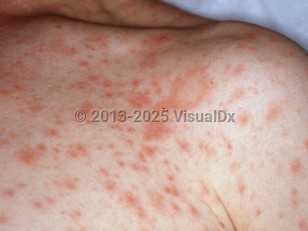Pityriasis rosea in Adult
Alerts and Notices
Important News & Links
Synopsis

Pityriasis rosea is usually pruritic but may also be asymptomatic. Constitutional symptoms may precede the eruption, including fever, headache, cough, and arthralgia. In most patients, the rash typically resolves within 12 weeks. Recurrence is rare.
Adolescents and young adults are most commonly affected, and it rarely occurs in children younger than age 10 years. Of note, pityriasis rosea occurring during pregnancy has been associated with increased risk of fetal demise and miscarriage, particularly if the lesions appear within the first 15 weeks of gestation. In pregnant individuals, the eruption may present in a more widespread distribution compared with classic pityriasis rosea and may be associated with systemic symptoms such as fatigue, headache, and loss of appetite. Close obstetric follow-up of pregnant patients with pityriasis rosea is recommended.
While the exact cause remains unclear, pityriasis rosea is thought to be associated with human herpesvirus 6 and 7 (HHV-6 and HHV-7) infection.
Certain drugs, such as captopril, clonidine, omeprazole, NSAIDs, metronidazole, terbinafine, lamotrigine, ibrutinib, domperidone, and dupilumab, among many others, can cause a pityriasiform eruption that resembles pityriasis rosea. Drug-related pityriasis rosea-like lesions may appear more red-violet in color, typically do not present with a herald patch, and may be associated with eosinophilia. Eruptions may also occur after vaccines, such as the COVID-19, smallpox, tuberculosis, and human papillomavirus (HPV) vaccines.
Codes
L42 – Pityriasis rosea
SNOMEDCT:
77252004 – Pityriasis rosea
Look For
Subscription Required
Diagnostic Pearls
Subscription Required
Differential Diagnosis & Pitfalls

Subscription Required
Best Tests
Subscription Required
Management Pearls
Subscription Required
Therapy
Subscription Required
Drug Reaction Data
Subscription Required
References
Subscription Required
Last Updated:12/04/2023
 Patient Information for Pityriasis rosea in Adult
Patient Information for Pityriasis rosea in Adult- Improve treatment compliance
- Reduce after-hours questions
- Increase patient engagement and satisfaction
- Written in clear, easy-to-understand language. No confusing jargon.
- Available in English and Spanish
- Print out or email directly to your patient


